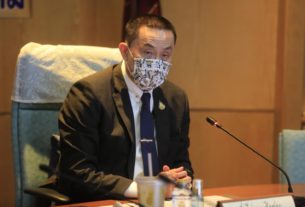
Austrian renewable energy model tried in Thailand
8 January 2019
Small town blueprint gasifies waste
An Austrian energy company has brought a new process for generating renewable energy to Thailand, with the hope that after initial success their model will spread to small towns across the country.
The carbon-neutral waste gasification plant in Nong Bua built by Gussing Renewable Energy (GRE) recently began supplying power to the area in November, turning agricultural and forest waste from the local community to energy that could power about 3,000 homes.
The company’s original power plant in Gussing, Austria improved the local economy by bringing jobs and supplying hot water and energy to the entire town, and GRE wants to replicate this system throughout Asia.
The plant has an electrical output of one megawatt (MW) and a fuel capacity of 4MW, with overall efficiency of around 75%. Some of the energy from the plant will be used for a 315-square-metre cold storage facility for farmers’ crops.
This is the first waste gasification plant built in Thailand.
The 250-million-baht project was a joint venture between GRE and Siam Cement Group (SCG), with research assistance from the Thailand Research Fund (TRF) and King Mongkut’s Institute of Technology Ladkrabang (KMITL).
Based on the success of the project, which took almost eight years to complete, GRE and SCG hope to open 1-5MW plants in small towns with populations of 10,000-50,000 throughout Thailand, for a total capacity of about 1,000MW.
The Nong Bua plant is essentially operating as a demonstration and test run for viability in other towns that wish to adopt the model.
“We chose Thailand because we could see communities were in need of the Gussing model, and there are ample raw materials available,” said Michael Messner, director of GRE Asia. “But it’s also about the local community, who are well educated about environmental projects and receptive to the idea of a renewable energy plant.”
The plant uses about 24 tonnes of biomass per day, which is essentially one truck load, a quantity that is readily available from the agricultural industry in Nong Bua.
Unlike many waste-to-energy plants that use dirty incinerators and have high emissions, the Gussing plant is “no burn”, but uses heat through the absence of oxygen to gasify biomass.
“Our principle is to reform this low-value carbon waste through our technologies into higher-value carbons in a carbon-neutral way that can be used for new forms of energy through electricity, heat, hydrogen and cold storage,” said Mr Messner.
The plant is technically carbon-neutral, as it accounts for the CO2 the biomass takes out of the atmosphere, which is then released after the final gas is burned as fuel. The system does not produce any waste water. The only byproduct is ash, which accounts for 2.5% of the mass put into the system, and can be reused as a soil conditioner in surrounding farms, or for cement.
In the future, the plant is expected to produce hydrogen and liquid kerosene that can be used in aeroplanes.
As part of the project, the TRF and KMITL researched a way to use biomass waste from the cassava root and palm oil industries. There is about 60,000 tonnes of cassava farmed per year in Nong Bua, but 10% is an inedible root that is wasted.
The test programme is not yet complete, but there have been positive results, said Dr Vilailuck Siriwongrungson, a professor and researcher at KMITL.
“This will be a great relief for the cassava and palm oil industries, and those who live around them, as before they burned their waste. Now it can be used for energy,” she said.
GRE worked with the local community to build enthusiasm for the project, which included public hearings to earn their support. The company sold the idea by showing how the plant could both manage local waste and provide cheap, clean energy to the town.
“Gussing saw the importance of working with local communities by looking at the local resources,” said Maj Gen Pairush Vimooktalop, chairman and senior adviser on the project. “The company has followed late King Bhumibol Adulyadej’s sufficiency economy guidelines by using few resources to maximise energy output. The government has really supported the idea.”
The Gussing model, according to Mr Messner, is to bring prosperity to “forgotten people” and towns, by allowing local control of energy, creating jobs and thus revitalising the community. As a result of GRE’s first plant in Gussing, the town was able to attract 50 new businesses and 1,500 new jobs by transforming the area into a green energy hub, all while cutting carbon emissions by 90%.
The town even earned praise from actor Arnold Schwarzenegger, who visited the GRE plant in 2012.
Whether this drastic revitalisation is transferable to small towns in Thailand is difficult to gauge, but GRE thinks there is a possibility.
“Gussing went from being very poor to very wealthy, and although it will be a big challenge, we hope we can do that here,” Mr Messner said.
Source: https://www.bangkokpost.com/business/news/1607310/austrian-renewable-model-gets-local-try



